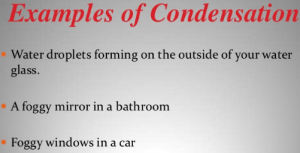Best Examples of Condensation In Daily Life

Examples of condensation in our daily life are provided here. If you want to learn about condensation and condensation Examples, then you are at the right place.
Keep Reading …
What is condensation?
The condensation is the change of state of matter which is in the forming gas and passes from the liquid. It is the reverse process of vaporization, if a transition from a gaseous state to a solid-state occurs directly, the process is called reverse sublimation or deposition. If a transition from liquid to solid state occurs, it is called solidification.
How Condensation Occurs?
Although the transition from gas to liquid depends, among other factors, on pressure and temperature, it is generally called traffic condensation that occurs at pressures close to ambient. When high overpressure is used to force this transition, the process is called liquefaction.
The condensation process usually takes place when a gas is cooled to its dew point, however, this point can also be reached by varying the pressure. The industrial or laboratory equipment necessary to perform this process artificially is called a condenser.
The science that studies the thermodynamic properties of humid air and the effects that the variation of atmospheric humidity has on materials and humans is called psychrometry. The interrelationships between the parameters that determine the condition of the humid air are represented in the psychrometric diagrams.
Condensation is a process governed by competing factors of energy and entropy. While the liquid state is more favorable from an energy point of view, the gas state is the most entropic.
Examples of Condensation
- Dew. The decrease in ambient temperature at dawn allows condensation of water vapor in the atmosphere on exposed surfaces, where it becomes drops of water known as dew. As soon as the temperature increases throughout the day said dew will evaporate and recover its gaseous form.
- The water cycle. The water vapor in the hot air normally rises to the upper layers of the atmosphere, where it encounters segments of cold air and loses its gaseous form, condensing into rain clouds that will again drop it in a liquid state on the earth.
- The “sweating” of cold drinks. Being at a lower temperature than the environment, the surface of a can or bottle filled with cold soda receives moisture from the environment and condenses it into droplets commonly referred to as “sweat”.
- The water from the air conditioners. It is not that these devices produce water, but that they collect it from the surrounding air, much colder than outside, and condense it inside them. Then it must be expelled through a drainage channel.
- Industrial gas management. Many flammable gases, such as butane or propane, are subjected to high pressures to bring them into their liquid form, which makes them much easier to transport and handle. Once exposed to the environment, however, they recover their gaseous condition and can feed circuits of various kinds, such as refrigerators or kitchens.
- Fog on the windshield. When driving through a fog bank, you will notice that the windshield is filled with water droplets, like very delicate rain. This is due to the contact of the water vapor with the surface, which, being colder, favors its condensation.
- The fogging of the mirrors. Given the coldness of its surface, mirrors and glass are ideal receivers of condensation of water vapor, as occurs when taking a hot shower.
- Obtaining chemical substances. Condensation is often used as a method of forcing certain gases obtained in chemical reactions to become liquids, thus preventing them from being lost by dispersing into the atmosphere. For this, they are made to pass through specially cooled ducts, in which the gas condenses and precipitates in another container.
- Aerosol performance. The substances contained in the aerosol cans: paints, pesticides, etc., are in a gaseous state inside, subject to certain pressure (that is why it is warned to heat or perforate the containers). Once the button is pressed, the gas is released under pressure and recovers its liquid consistency in contact with the atmosphere.
- The fogged-up diving goggles. Similar to what happens when taking a hot shower, the air contained between the glasses of the diving goggles and our face contains water vapor as a result of the perspiration of the face and the environment from which it came, and being under the water (whose temperature is lower than air), condenses on the glass forming a visible film.
- Liquefied Petroleum Gas (LPG). One of the substances derived from petroleum is this mixture of gaseous hydrocarbons that are extremely easy to liquefy, that is, to convert into liquids with increasing pressure in the container. That’s where its name comes from, of course.
- Liquid nitrogen from cryogenics. Subject to significant pressures and temperature of -195.8 ° C, nitrogen gas becomes a colorless and odorless liquid, capable of causing burns due to its extremely low temperature. It is extremely useful for the cryogenic industry.
- The vapor of the breath. If we breathe in front of the glass or breathe in a low temperature and high humidity environment, we can see water vapor as tiny droplets in the first case or white smoke in the second. This is because the air in our lungs is hotter than glass or cold vapor in the environment, so it condenses and becomes visible.
- Additional heat in humid environments. This sensation, which prevents the cooling by sweating of our skin, is the product of the condensation on it of the water vapor of a particularly hot environment, thus transmitting an additional amount of heat to our body (colder than the air around it).
Related Topics:
